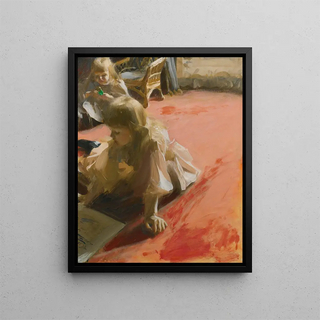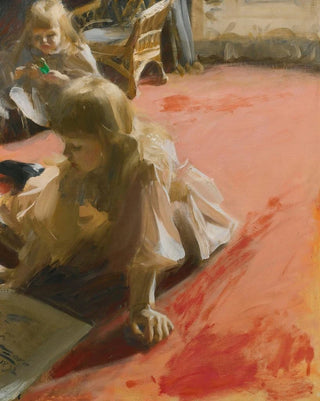Painting A portrait of Ramón Subercaseaux's daughters - Anders Zorn | Art print


View from behind

Frame (optional)
The artwork "A portrait of Ramón Subercaseaux's daughters" by Anders Zorn immerses us in a universe where light and color intertwine to capture the very essence of childhood. Created in 1890, this painting evokes not only the tenderness of a father for his daughters but also the sensitivity of an artist who masterfully translated deep emotions through his brush. Zorn, a master of portraiture, manages to immortalize a fleeting moment, a complicity between the two young girls, who seem both joyful and dreamy. This piece, both intimate and universal, invites us to explore family bonds and memories of a bygone era.
Style and uniqueness of the work
Anders Zorn's style is characterized by an exceptional mastery of light and shadow, as well as a palette of vibrant colors that breathe new life into his subjects. In "A portrait of Ramón Subercaseaux's daughters," Zorn employs quick, fluid strokes, creating an effect of movement and spontaneity that makes this scene particularly lively. The faces of the girls, delicately modeled by light, seem almost tangible, while the drapery of their clothing adds a tactile dimension to the work. The composition is carefully balanced, with a blurred background that highlights the central figures without overpowering them. This approach allows the viewer to focus on the expressions and interactions of the characters, while being enveloped in an atmosphere of softness and warmth.
The artist and his influence
Anders Zorn, an emblematic figure of Swedish painting, established himself on the international art scene thanks to his undeniable talent and innovative approach. Born in 1860, he studied at the Royal Swedish Academy of Arts in Stockholm before traveling across Europe, absorbing the artistic currents of his time. Zorn was influenced by masters such as Rembrandt and Manet but developed a style that is uniquely his own, blending realism and impressionism. His work had a significant impact on his contemporaries and continues to inspire many artists.

Matte finish

View from behind

Frame (optional)
The artwork "A portrait of Ramón Subercaseaux's daughters" by Anders Zorn immerses us in a universe where light and color intertwine to capture the very essence of childhood. Created in 1890, this painting evokes not only the tenderness of a father for his daughters but also the sensitivity of an artist who masterfully translated deep emotions through his brush. Zorn, a master of portraiture, manages to immortalize a fleeting moment, a complicity between the two young girls, who seem both joyful and dreamy. This piece, both intimate and universal, invites us to explore family bonds and memories of a bygone era.
Style and uniqueness of the work
Anders Zorn's style is characterized by an exceptional mastery of light and shadow, as well as a palette of vibrant colors that breathe new life into his subjects. In "A portrait of Ramón Subercaseaux's daughters," Zorn employs quick, fluid strokes, creating an effect of movement and spontaneity that makes this scene particularly lively. The faces of the girls, delicately modeled by light, seem almost tangible, while the drapery of their clothing adds a tactile dimension to the work. The composition is carefully balanced, with a blurred background that highlights the central figures without overpowering them. This approach allows the viewer to focus on the expressions and interactions of the characters, while being enveloped in an atmosphere of softness and warmth.
The artist and his influence
Anders Zorn, an emblematic figure of Swedish painting, established himself on the international art scene thanks to his undeniable talent and innovative approach. Born in 1860, he studied at the Royal Swedish Academy of Arts in Stockholm before traveling across Europe, absorbing the artistic currents of his time. Zorn was influenced by masters such as Rembrandt and Manet but developed a style that is uniquely his own, blending realism and impressionism. His work had a significant impact on his contemporaries and continues to inspire many artists.
12,34 €






